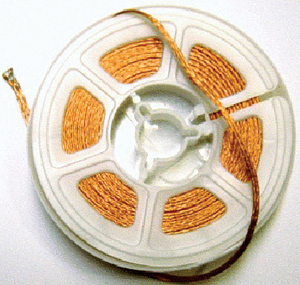 Soldering wick. De-soldering wick, also known as de-soldering braid, is a must-have component in a toolkit. It is a finely braided 18 to 42 AWG copper wire coated with rosin flux, usually supplied on a roll. This is a highly useful component to remove excess solder on the PCB board. One end of a small length of braid is placed over the heated soldered joint where the solder needs to be removed. The joint is heated with a soldering iron until the solder melts and is wicked into the braid by capillary action. The braid is removed immediately, carrying away the molten solder.
Soldering wick. De-soldering wick, also known as de-soldering braid, is a must-have component in a toolkit. It is a finely braided 18 to 42 AWG copper wire coated with rosin flux, usually supplied on a roll. This is a highly useful component to remove excess solder on the PCB board. One end of a small length of braid is placed over the heated soldered joint where the solder needs to be removed. The joint is heated with a soldering iron until the solder melts and is wicked into the braid by capillary action. The braid is removed immediately, carrying away the molten solder.
Flux. Flux is normally used to remove oxide coatings and impurities from the metals that are being joined. This oxidation accelerates as the soldering temperatures increase and can completely prevent the solder from joining to the metal joint. Applying flux on the joint before soldering it gives good quality results. There are several types of flux available, like rosin, water-soluble and no-clean flux. You can choose any one but no-clean flux is the most commonly used these days as you don’t have to clean the residue after soldering.
Magnifier. There are several types of magnifiers available in the market, like triplet loupe, clamp stand with magnifier and three-lens multi-magnifier, and you will definitely need one in your toolkit to inspect the quality of joints and shorting. If you need to work for longer hours, consider buying a head-mounted magnifier that has three lenses: one binocular lens, a second binocular lens behind the first that flips up, and a pivoting loupe. You can use different combinations of these lenses to achieve magnifications like 1.8X, 2.3X, 3.7X and 4.8X.
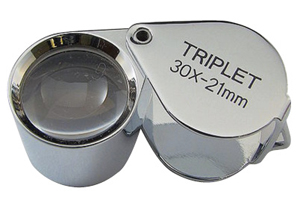
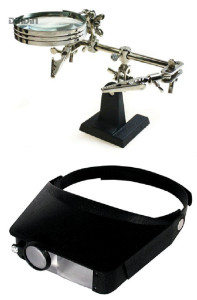
PCB holder. PCB holders are a bit overrated but you may need these helping hands in many cases. For instance, the simple task of tinning the wires becomes very easy with a PCB holder. Soldering components on the PCB becomes a little more comfortable when the PCB is mounted on a PCB holder.
Hand tools
There are a large number of hand tools, some of which you need to use very frequently for electronics jobs. These tools are a must-have in the toolkit, and here you should not compromise on their quality at all.
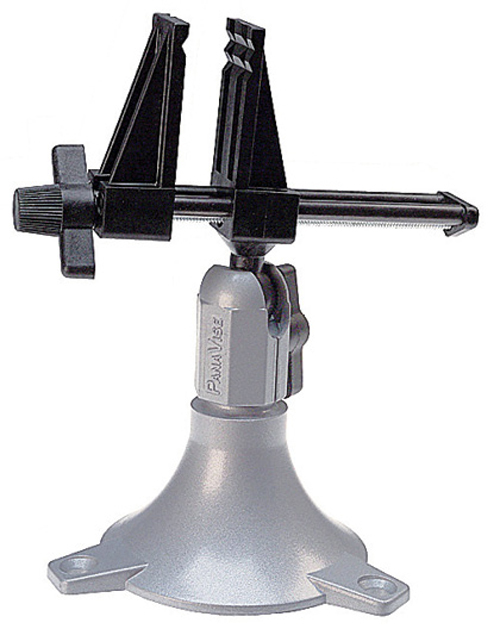
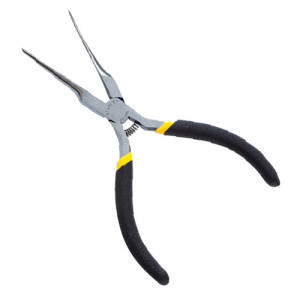 Needle-nose pliers. Needle-nose pliers, also known as pinch-nose pliers, are used for bending, plying, forming, holding, squeezing and gripping all those little components. Their precise long gripping nose provides excellent control and reach for fine work, which is a great convenience. Look for a micro-needle-nose plier, which is precise enough for all the jobs that you would ever come across in electronics.
Needle-nose pliers. Needle-nose pliers, also known as pinch-nose pliers, are used for bending, plying, forming, holding, squeezing and gripping all those little components. Their precise long gripping nose provides excellent control and reach for fine work, which is a great convenience. Look for a micro-needle-nose plier, which is precise enough for all the jobs that you would ever come across in electronics.
Tweezers. Tweezers are also used in several applications other than electronics, and there is a huge variety available in the market. In electronics, micro tweezers, which have an extremely small, pointed tip, are used for manipulating small electronic components. These micro tweezers come in various shapes but you would need only a straight and bent one.







how to purchase electronics toolkit